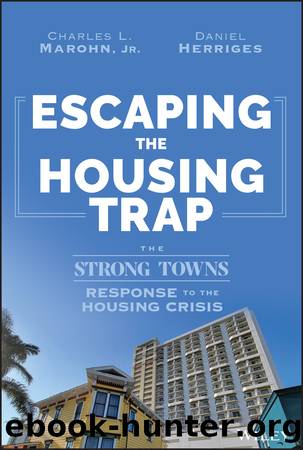Escaping the Housing Trap by Charles L. Marohn Jr. & Daniel Herriges

Author:Charles L. Marohn, Jr. & Daniel Herriges [Marohn, Charles L. & Herriges, Daniel]
Language: eng
Format: epub
ISBN: 9781394198306
Publisher: Wiley
Published: 2024-04-23T00:00:00+00:00
Homevoters versus the Growth Machine (Spoiler: They Both Win)
It would be too simplistic to suggest there is no countervailing force at work here. There is: it's just that the status quo of growth politics ends up being a compromise largely acceptable to many interest groupsâall except those who need housing to be cheaper.
For decades, two theories have dominated the academic study of how local political power operates. One theory, associated with the political scientist William Fischel (2005), is the âhomevoter hypothesis.â Fischel argues that homeowners whose primary interest is in maintaining their property values are a powerful and often dominant interest group in city politics.
The other theory, associated with sociologist Harvey Molotch, is that of the âgrowth machine.â Molotch wrote in 1988 that âvirtually all U.S. cities are dominated by a small, parochial elite whose members have business or professional interests that are linked to local development and growth. These elites use public authority and private power as a means to stimulate economic development and thus enhance their own local business interestsâ (Molotch 1988).
A coalition resembling Molotch's growth machine wields significant political power in many cities large and small. Real estate developers are often major campaign donors. Money buys influence, but there is also a more basic convergence of interests. City officials want a tax base to fund the services they provide. Developers create that tax base.
Most âneighborhood defenderâ development opponents identify something like the growth machine as their bête noire. âCitizens versus developersâ is the narrative of choice of many, perhaps most, of the NIMBY contingent.
What is not true is that the interests of the growth machine stand in straightforward opposition to the interests of homeowners. These are both powerful constituencies, and the system we have is basically a compromise that works for both of them. If it didn't, it probably wouldn't endure.
To be clear, homevoters and growth advocates have genuine, sincere disagreements and fight bitterly over specific projects. It's just that the system as a whole ends up basically acceptable to both sets of interests.
The big development interests get the ability to build at large scales in specific, limited contexts: suburban subdivisions and large-scale urban infill in the minority of places where it is allowed. They get a land-use regime that, as we discussed in Chapter 5, provides ample opportunity for speculation and windfall gains. They also get an often convoluted regulatory system in which they have an advantage as insiders.
Entrenched developers don't need or necessarily want to maximize housing production region-wide; if anything, the resulting abundance and competition would cut into their profit margins. The developers most likely to be part of a politically connected growth machine occupy a privileged position as insiders in a sector with substantial barriers to entry.
The homevoters get their own neighborhoods mostly insulated from change (though the most ideological opponents of development in general may end up disappointed). They get a substantial amount of input and deference in the political process. And overall housing scarcity means that they get to reap the benefits of home value appreciation, as surely as land speculators in the real estate industry.
Download
This site does not store any files on its server. We only index and link to content provided by other sites. Please contact the content providers to delete copyright contents if any and email us, we'll remove relevant links or contents immediately.
The Secret History by Donna Tartt(16662)
The Social Justice Warrior Handbook by Lisa De Pasquale(11494)
Thirteen Reasons Why by Jay Asher(7802)
This Is How You Lose Her by Junot Diaz(5799)
Weapons of Math Destruction by Cathy O'Neil(5046)
Zero to One by Peter Thiel(4834)
The Myth of the Strong Leader by Archie Brown(4796)
Promise Me, Dad by Joe Biden(4455)
Beartown by Fredrik Backman(4434)
Stone's Rules by Roger Stone(4423)
How Democracies Die by Steven Levitsky & Daniel Ziblatt(4414)
The Fire Next Time by James Baldwin(4350)
100 Deadly Skills by Clint Emerson(4085)
A Higher Loyalty: Truth, Lies, and Leadership by James Comey(4039)
Rise and Kill First by Ronen Bergman(4021)
The David Icke Guide to the Global Conspiracy (and how to end it) by David Icke(3891)
The Farm by Tom Rob Smith(3878)
Secrecy World by Jake Bernstein(3788)
The Doomsday Machine by Daniel Ellsberg(3737)
